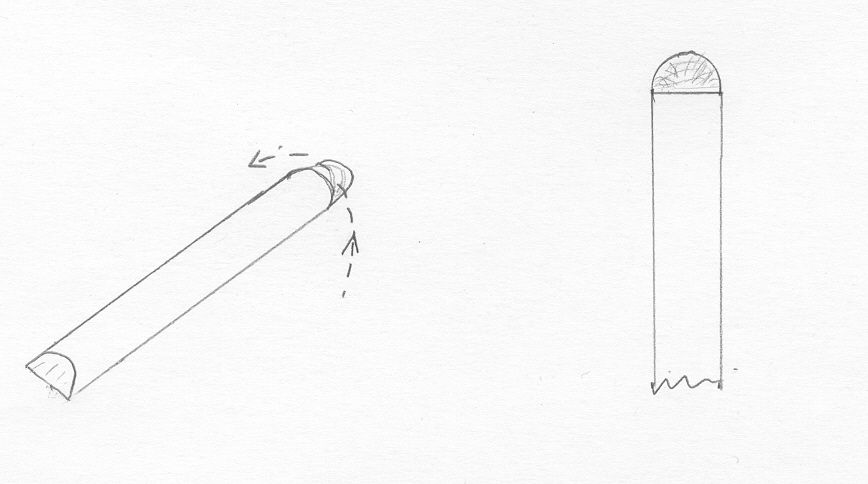Fretwork- Semi-Hemispherical Fret Ends
© 2004 Alan Dunwell
This part is done prior to gluing in the fretboard binding.
- It is necessary to prepare the fret wire here ahead of time. Use the tang
filing jig and make one length of wire with undersized tangs. Mark the tang
side of the undersized wire with a colored Sharpie to avoid confusion.
- Pre-curve two lengths of fret wire, one full sized tang and one under sized.
- Cut fret wire to length, make sure you leave enough to reach out over the
binding that will be installed. Under cut the tang with the special clippers
to be just short of the binding slot. Use the undersized tang wire for the
frets above the 12/14th body joint. This will minimize the back
bow on the unsupported extension.
Now bind fretboard.
and...
- With the special holding jig or other device to hold the fret, invert
each fret and smooth off and remnants of the tang where it was clipped
off. This is necessary to get it to sit tight to the fretboard.
- Use a long straight edge and draw pencil lines down each side about 1/32nd or
2/32nds in from the edge. This is the mark for aligning the
ends of the frets to get them all true lengths.
- Pick a side that will be the reference, I use the treble side. Use the
tang end as a guide in the slot and position a fret, make the tang just
butt up to the binding. Press it in a little to make some dents with the
barbs to act as locators for when we press in . Clip it to approximate
length.
- File and smooth the end to be semi-hemispherical using the following
method:
- file one end to align with the pencil line on the neck. Use the tang
dents we made as a consistency guide.
- hold with the tang towards you and file a shallow 45 angle off the
corner. Reverse so the tang is away and do the same. Count number of
strokes on each side, probably about three or four, and make them even
so an equal amount is taken off each side. Now round off the corners
to make a smooth semi-circle profile, try to avoid taking any off the
end or that will modify our alignment with the pencil line and get the
tang too close to the binding. Check the fit on the neck and re-cut the
tang if necessary.

- hold so the tang is to the side (left if right handed), file another
low angle 45 to form the break over along the top line.
- just knock off the facet lines between these 45 sections.

- with a rolling motion file from one side up and over the top and down
the other side to set the line at the end of the fret where the semi-hemisphere
starts. With small strokes, equal on each side, smooth all angles and
edges into a smooth half hemisphere.

- very slightly flex down the ends that will overhang the binding.
This should be just visible when viewed from the side, not a big bend.
This makes sure that the ends are fully down to the fretboard when pressed
in.
- sand the end smooth with 240, 320, 400, 600, 1000 grit papers. Watch
for flats and scratches left from the file. Use 2X glasses and get all
file marks out or they will show later when the fret is polished.
- repeat on the other end. Note that you will have to start on the second
end by clipping the end long and slowly file it to shorten the fret to
almost fit to the pencil lines on the FB. Leave it just a little long
to start and then fit it exactly in the step before sanding smooth.
- just knock the sharp corners off the ends of the tang to avoid them
binding when pressed in.
- repeat for all frets. When you get beyond the 12/14th body line fret
switch to the fret wire with the reduced tang. We don't want any fret
tang compression in the extension. Some nice music and tea breaks help
to keep you relaxed and focused on the task.




